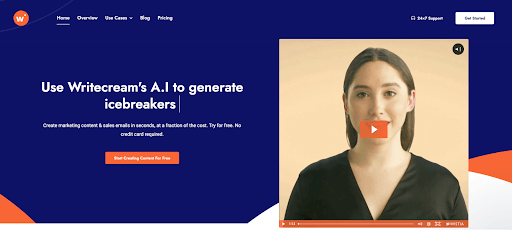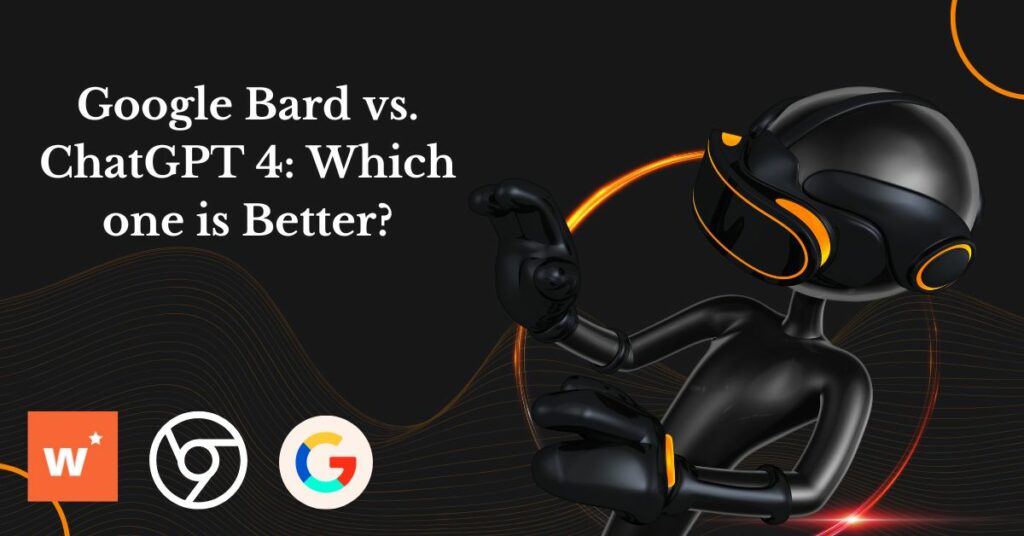Language models have made major advances in the field of artificial intelligence, resulting in interesting opportunities for natural language processing and creation. Google Bard and ChatGPT 4 are two major instances of such models, each with its own set of features, advantages, and disadvantages. In this post, we will look at the key functional differences between Google Bard and ChatGPT 4, compare their capacities to create coherent and contextually appropriate answers, and analyze the issues that both models confront.
Overview of Google Bard and ChatGPT 4
Google Bard is a language model developed by Google Research that specializes in poetry generation. It is trained using a method called Reinforcement Learning from Human Feedback (RLHF), where human poets generate multiple completions for a given prompt, and these completions are ranked by quality.
ChatGPT 4, developed by OpenAI, is the fourth iteration of the ChatGPT series. It is a conversational AI model that aims to provide a more interactive and engaging conversation experience. ChatGPT 4 has been trained on an extensive dataset comprising of 300 million dialogue examples sourced from the internet. Through this massive dataset, the model learns to understand and generate conversational responses across a wide range of topics.
When asked for his opinion on which he prefers better, Elias Pedersen, Senior Mortgage Broker, and Co-Founder at Smartfinans.no stated, “Text requests can be easily created and composed using ChatGPT. Bard does a better job of providing material that is more pertinent to the queries asked.”
“ChatGPT tends to produce less hallucinated or fabricated information. This means it’s less likely to generate information that doesn’t exist in reality, compared to Google Bard, which has a higher tendency to produce such content,” another expert Yusuf Cay, Owner and CEO of chatgptplus.blog opined.
Khaled Bentoumi who is the Co-Founder of anyIP upon being asked also answered in the same lines that, “ChatGPT makes it simple to construct and compose text requests. When it comes to giving information that is more relevant to the questions posed, Bard performs a better job.”
Functionality Differences between Google Bard and ChatGPT-4
Peter Smith, Managing Director of Marble Horse“ created a table of what he believes is a fair assessment of the two large language models Criteria ChatGPT vs Google Bard rspectively. It is as follows:
- Memory 8/10 vs 6/10
- On topic 9/10 vs 4/10
- Grammar 9/10 vs 8/10
- Lack of Hallucinations 8/10 vs 6/10
1. The functionality of Google Bard
While talking about functionality of Google Bard, Dale Williams, owner of Bloom’d Florist stated that. “your on-call AI assistant, Google Bard, can help with content creation, editing, and tricky client inquiries. I believe it’s because Google Bard offers numerous chances for in-the-moment market research thanks to its outstanding capacity to gather information from the internet. You’ll rapidly be aware of market trends and client preferences as a result.”
The following are some significant features of Google Bard:
- Artistic Expression: Google Bard is well-suited for creative writing, such as poetry, music lyrics, and narrative. It may enhance text-based applications with aesthetic flare and originality.
- Writing that is Aesthetically Pleasing: The model has been taught to generate cohesive and engaging writing with a heavy emphasis on aesthetics. It is capable of producing vivid descriptions and enticing words.
- Limited Technical and Factual Information: Rather than offering factual or technical information, Google Bard’s major strength is creative expression. It might not be the ideal option for applications that need exact, truthful replies.
2. The Functionality of ChatGPT 4
Adam Karl, Founder/HRO of herobot.app stated, “ChatGPT 4, with its extensive training on diverse datasets, offers a broader range of conversational abilities. It can provide more contextually accurate responses by leveraging the knowledge it has acquired during training. However, like any AI model, it can still exhibit limitations, such as occasional factual errors or responses that lack deep understanding.”
The following are the key features of ChatGPT 4:
- Conversational Interaction: ChatGPT 4 has been taught to recognize and respond to user requests in a conversational way. It can have a lengthy discussion and preserve context throughout.
- Contextually Relevant Responses: The methodology uses information gleaned from the dialogue to develop contextually relevant responses. It seeks to give useful and relevant replies in response to user requests.
- Versatility: The architecture of ChatGPT 4 makes it an excellent solution for chat-based apps, virtual assistants, and customer support systems. It is capable of handling dynamic dialogues and comprehending user intents.
3. Distinction and comparison between Google Bard and ChatGPT-4
The following are the key functional changes between Google Bard and ChatGPT 4:
- Artistic vs. Conversational Focus: Google Bard promotes artistic expression above conversational focus, making it appropriate for creative writing applications. ChatGPT 4 is designed to provide contextually relevant replies during conversational exchanges.
- Aesthetics vs. Interactivity: Google Bard strives to create aesthetically attractive and innovative language, whereas ChatGPT 4 prioritizes engaging and contextually correct interactions.
- Limited Technical Knowledge: While Google Bard may struggle to deliver accurate technical or factual information, ChatGPT 4 is meant to handle a broader variety of inquiries and provide more contextually appropriate replies.
- User interface: Google Bard has a more user-friendly interface than ChatGPT 4. Bard’s responses are formatted in a way that is easy to read and understand, and it also provides a Google it button that allows users to verify the accuracy of Bard’s responses”, quoted Jazmine, Head of Marketing at FlexiPCB.
Limitations and Challenges
Matt Weigand, President of Utica Dental Lab. while throwing some light on the limitations of AI Tools stated, “Despite recent advancements in chatbot technology, genuine emotional intelligence and empathy cannot yet be totally replaced. Lack of empathy makes it more challenging for chatbots to provide consumers with a rich and pleasurable experience, which can be a big downside.”
- Bias in Training Data: Language models like Google Bard and ChatGPT 4 are trained on massive volumes of internet data, which may contain biased or improper information. This presents difficulties in ensuring that the models deliver impartial and ethical results.
- Ethical Considerations: Addressing biases and ethical problems connected with AI language models is a continuous task. Attempts are made to enhance training data, reduce biases, and promote fairness in produced text.
- Limited Contextual Understanding: Language models may lack real-world information and struggle to interpret complex or ambiguous inquiries due to a lack of contextual awareness. They rely heavily on training data and may provide incorrect results when confronted with difficult or new topics.
- Contextual Overfitting: Models like Google Bard and ChatGPT 4 might be extremely particular in their responses, producing overly comprehensive answers that may not match user expectations.
Marnix Broer, Co-founder & CEO of Studocu brought up some interesting points on ChatGPT. He quoted “I’ve been shocked at how often Bard simply tells me it can’t do something, even if the request would have been handled easily by ChatGPT. I’ve even seen Bard do something once and then refuse to do it again later, with a virtually identical prompt. No explanation, no suggestions. It’s frustrating.”
Industry-Specific Use Cases
“As for industry-specific use cases, language models have found application across various domains, including customer support, content generation, and education. However, each model’s performance may vary depending on the specific requirements and nuances of the industry or use case.” cited Nick Walker CEO of DashTickets, while comparing Bard and ChatGPT.
Where Google Bard Outperforms ChatGPT 4
While highlighting where Bard is preferable to ChatGPT, Jan Chapman, Co-Founder and Managing Director of MSP Blueshift stated, “I believe the reliability of data is where Google Bard outperforms because ChatGPT4 is a data-driven model; it is susceptible to receiving incorrect or unreliable data, which could cause it to produce inaccurate or unreliable information.”
- Creative Writing and Artistic Sectors: Because Google Bard’s major strength is artistic expression, it is the favored choice for sectors that demand creative writing, such as songwriting, narrative, and content production.
- Poetry and music Lyrics: Google Bard excels in generating poetic language and crafting music lyrics. It can generate rhymes, metaphors, and rhythmical patterns that meet the needs of poets, songwriters, and lyricists.
“Google Bard, interconnected with Google’s comprehensive ecosystem is handy for ecommerce or digital marketing businesses. Drawing upon a wealth of search engine data, it provides personalized suggests based on trending searches or buyer behavior – augmenting SEO strategies for these industries remarkably,” cited Andi Merovci, SEO Team Lead at Ajroni.
ChatGPT 4 Outperforms Google Bard
- Conversational Applications: ChatGPT 4 is specially built for producing conversational answers, making it the superior alternative for applications that demand interactive communication. It is capable of simulating human-like discussions and engaging people in a chat-based environment.
- Dynamic Information Retrieval: The power of ChatGPT 4 comes in its ability to interpret user queries and provide contextually appropriate replies. It can deal with a wide range of issues and give real-time data. News agencies, information services, and knowledge-based platforms that require dynamic information retrieval can benefit from ChatGPT 4’s ability to deliver accurate and informative replies.

Conclusion
In conclusion, after considering the opinions of industry experts, it is clear that both Google Bard and ChatGPT4 have their strengths and weaknesses. However, for those seeking a fantastic alternative that balances affordability and quality responses, Writecream’s ChatGenie emerges as a top contender.
Writecream’s ChatGenie offers a powerful AI chatbot that is not only cost-effective but also ensures reliable and accurate responses to queries. With its user-friendly interface and advanced technology, Writecream provides an unparalleled chatbot experience that rivals the capabilities of both Google Bard and ChatGPT4.
If you are looking for a reliable and affordable solution to meet your AI Assistant needs, we highly recommend trying Writecream’s ChatGenie. Don’t miss out on this opportunity to explore the future of AI. Sign up for Writecream today and enjoy free benefits!


